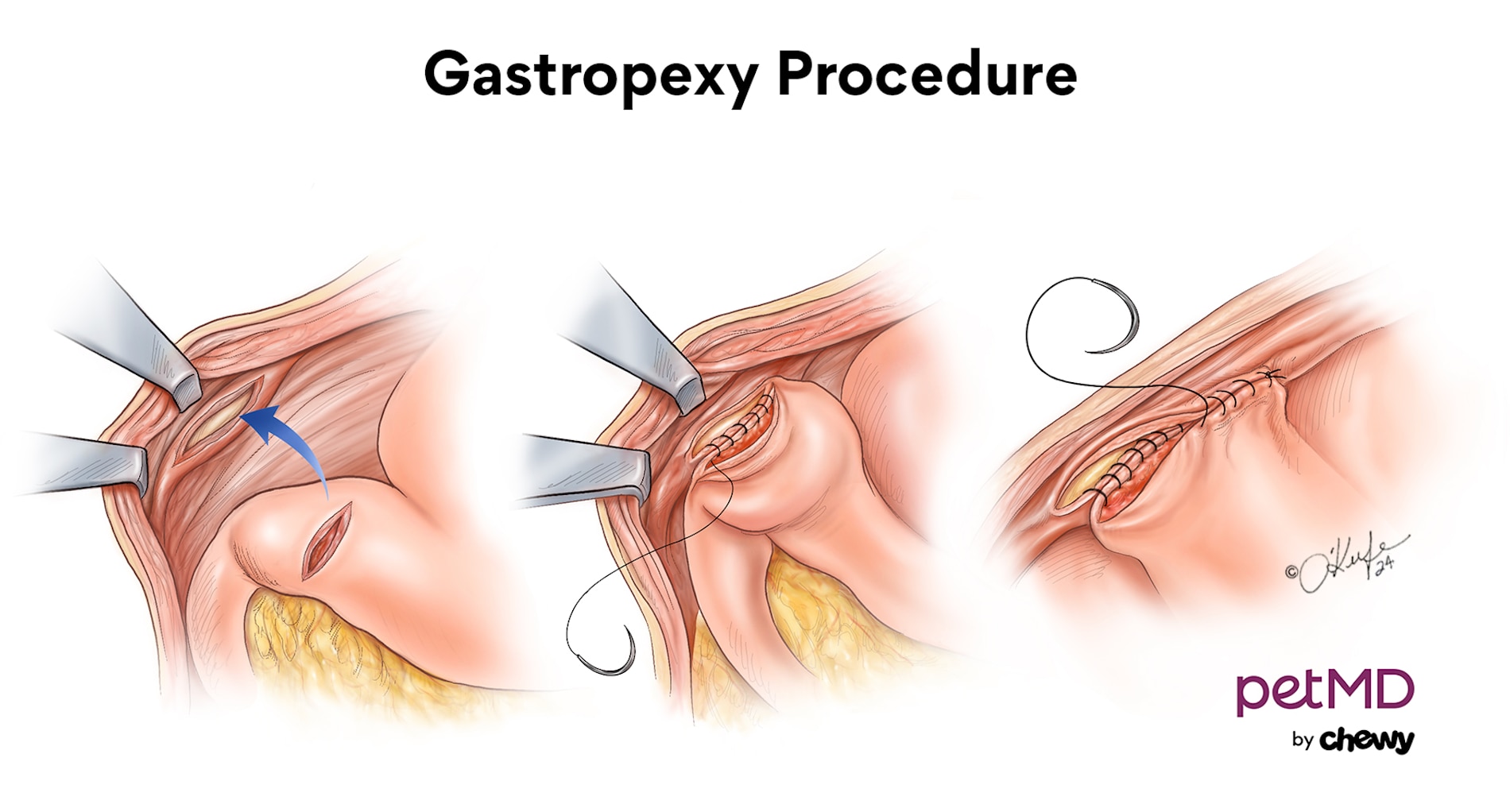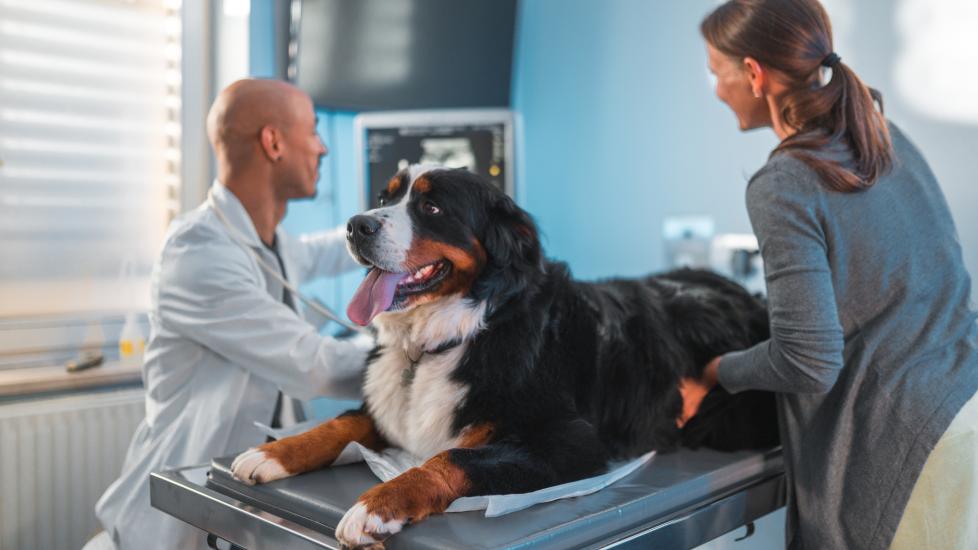Gastropexy in Dogs
What Is Gastropexy in Dogs?
A gastropexy procedure isn’t something that most dog parents are familiar with, but if you have a large, deep-chested dog like a Great Dane, or a dog who experiences bloat, you may find yourself discussing this preventative surgery with your vet.
A gastropexy involves securing the stomach to the abdominal wall to maintain its normal anatomical position. This procedure is specifically designed to prevent the stomach from twisting on itself.
Gastropexies are recommended for dogs who are at risk of developing a condition known as gastric dilatation and volvulus (GDV). GDV occurs when the stomach fills with gas and dilates, or expands, commonly known as “bloating.” If the gas-filled stomach twists upon itself (volvulus), both the entrance and exit to the stomach become obstructed. The dilated stomach exerts pressure on the major veins in the abdomen, impeding blood circulation to the heart.
If left untreated, a dog with GDV will go into shock, making it a life-threatening condition that requires emergency surgery.
While gastropexies don’t prevent dilatation (bloat), they do prevent volvulus (twisting).
Although GDV is most common in large, deep-chested dogs, it can occur in any dog. If your dog has previously experienced bloat, preventative gastropexy may be worth considering, as recurrence of bloat and GDV are very high in dogs without this procedure. Gastropexies are commonly performed as preventative surgeries in large, deep-chested dogs.
Anatomy of a Gastropexy in Dogs
“Gastro” means stomach, and “pexy” means fixation. For a gastropexy in dogs, a permanent adhesion is formed between the stomach and the right abdominal wall, holding the stomach in its normal anatomical position.

During the procedure, the outer layers of the stomach, including its covering (serous layer) and a muscular layer, are cut. These layers are then attached to the dog’s abdominal wall either by anchoring them to an incision or passing a flap of the stomach’s outer layer through a tunnel made in the abdominal wall.

In a gastropexy procedure in dogs, an incision is made in both the stomach (serosa and muscle layers) and the body wall. Next, the stomach wall edges are sutured to the abdominal wall.
In the final step, suture lines form a permanent adhesion to hold the stomach securely to the abdominal wall.
Types of Gastropexies in Dogs
Many private practice veterinarians will perform preventative gastropexies in your average veterinary clinic. Emergency gastropexies, which are needed if your dog is experiencing GDV, are usually done in an emergency clinic.
If you’re considering a preventative gastropexy, check with your veterinarian to see if this is something they can do. Outside of that, specialty centers and veterinary colleges will do gastropexies.
Numerous techniques exist for performing gastropexy in dogs. Here are four common types of gastropexies:
-
Incisional gastropexy—An incision is made in the outer layers of the stomach and sutured to an incision in the abdominal muscles. This is the fastest technique and has fewer complications than other forms of gastropexy, so it’s the most common method used by veterinarians.
-
Belt-loop gastropexy—A flap of the outer layers of the stomach is passed through a soft tissue tunnel in the abdominal wall to attach the stomach to the area.
-
Circumcostal gastropexy—A flap of the outer layers of the stomach is passed through a tunnel behind the last full rib and sutured back to the stomach. Circumcostal means “around a rib.”
-
Laparoscopic-assisted gastropexy—Endoscopes are passed into the abdomen, and the surgery performed is basically the same as an incisional gastropexy. In clinics with laparoscopic capabilities, this may be the technique of choice. Incisions are usually smaller than what is needed for other techniques.
There are more gastropexy methods, but incisional or laparoscopic-assisted gastropexies are typically preferred.
Why Would a Dog Need a Gastropexy?
There are a few important reasons that a gastropexy might be ideal for your dog.
These include that your dog:
-
Is experiencing bloat or GDV: Gastropexy would be performed as part of the surgery to resolve the GDV.
-
Is a large, deep-chested dog breed at risk of GDV, such as a:
-
Has a known family history of GDV: First-degree relatives may have an increased risk.
Keep in mind that this list of at-risk dog breeds is not all-inclusive. Some mixed-breed dogs may also be at risk for GDV if they are large and deep-chested. If your veterinarian is recommending gastropexy for your dog, consider pursuing the surgery.
Risks of Gastropexy in Dogs
As with most other surgical procedures, there are some risks associated with gastropexy, including:
-
Gastrointestinal upset (vomiting, diarrhea, poor appetite), which usually resolves on its own over a couple of days
-
Infection of the incision site
-
Formation of seroma (the collection of fluid in a small area, like a cyst)
-
Bleeding
-
Laceration of the spleen (more common with laparoscopy)
-
Reactions to anesthesia
GI upset is the most common issue after gastropexy in dogs. Gastropexies are usually considered a simple procedure. However, a dog undergoing gastropexy as treatment for GDV may have other complications due to their twisted stomach, such as large vessel compression or lack of blood flow to the spleen.
Benefits of Gastropexy in Dogs
Preventative gastropexies reduce the risk of life-threatening GDV in dogs, giving you peace of mind.
You can also feel more confident that if your dog does experience bloat, it’s unlikely to progress to volvulus.
Bloat without volvulus can often be resolved medically without having to undergo surgery, but when volvulus occurs, the stomach must be surgically returned to its normal anatomical position.
Effectiveness of Gastropexies in Dogs
One study found that the lifetime risk of death from GDV for five dog breeds ranged from 3.9% in Rottweilers to 36.7% in Great Danes.
Great Danes who have preventative gastropexies are about 30 times less likely to die from GDV than Great Danes who haven’t had the surgery.
Incisional gastropexies reduce the recurrence rate of GDV from as high as 80% to under 5%.
Cost of Gastropexy in Dogs
A non-emergency, preventative gastropexy can be performed at the same time as the spay or neuter procedure in a younger dog. The gastropexy component of the surgery is usually several hundred dollars, though laparoscopic techniques may cost more.
An emergency gastropexy performed in response to GDV in dogs is more expensive, easily costing $1,500 or more. The bill will also include any necessary stabilization and monitoring after surgery, which can increase the cost to several thousand dollars.
Some pet insurances will cover preventive gastropexies under pet wellness plans, but always check with your insurance provider. Emergency gastropexies may be covered unless bloat or GDV is considered a pre-existing condition for your dog.
Preparation for Gastropexy in Dogs
Your dog will need to fast prior to the procedure. Make sure to get precise instructions from your veterinarian regarding how long your dog’s fasting period needs to be.
Your dog will have their abdomen shaved while at the clinic, and the veterinary team will use a scrub on your pet to ensure the procedure is sterile.
Post-Op Care and Recovery for Gastropexy in Dogs
After a gastropexy procedure, your dog will need to be kept calm for 7 to 10 days. Always follow your veterinarian’s specific instructions regarding exercise restriction. This includes no running, jumping, or rough play.
The incision should be kept clean and dry until it’s healed. You will need to avoid bathing your dog during their recovery, and your pup should not go swimming.
This also means your dog must not be allowed to lick or chew at their incision. To prevent licking, chewing, and scratching of the incision, consider a recovery cone or suit.
Your dog will also be sent home with pain medications, which will be selected at the doctor’s discretion. Give these exactly as instructed.
If your dog underwent a gastropexy as part of an emergency procedure, they will remain in the hospital for several days. These dogs may go home with additional prescription medications, including antibiotics.
Alternatives to Gastropexy in Dogs
Gastropexies are considered the most effective method for preventing GDV in dogs. Some veterinarians may be willing to reduce a bloated stomach with endoscopy, but this will not prevent recurrence of bloat and potential volvulus.
A tube placed through the abdominal wall into the stomach may also be used to allow feeding directly into the stomach and prevent recurrence. These tubes come with the risk of infection and require more intensive postoperative management.
Supportive ways to decrease the risk of GDV include:
-
Feeding multiple small meals throughout the day instead of one large meal
-
Feeding at-risk dogs from floor level rather than an elevated bowl
-
Using slow feeders to slow your pup’s speed of eating
While large meals, rapid eating, and eating from an elevated level are considered risk factors for developing GDV, a dog who does none of these can still develop GDV.
Gastropexy in Dogs FAQs
Is gastropexy surgery worth exploring for dogs?
Gastropexy is effective at preventing recurrence of GDV in dogs. If your veterinarian is recommending gastropexy for your pet, it is highly recommended you consider it.
Featured Image: AzmanL/E+ via Getty Images
